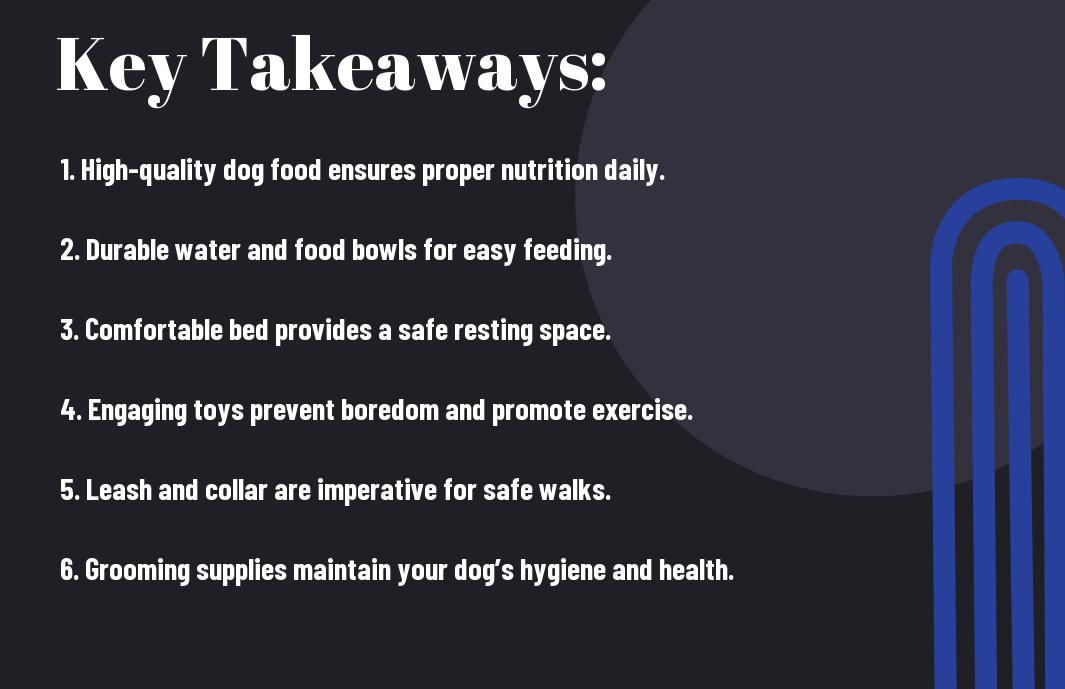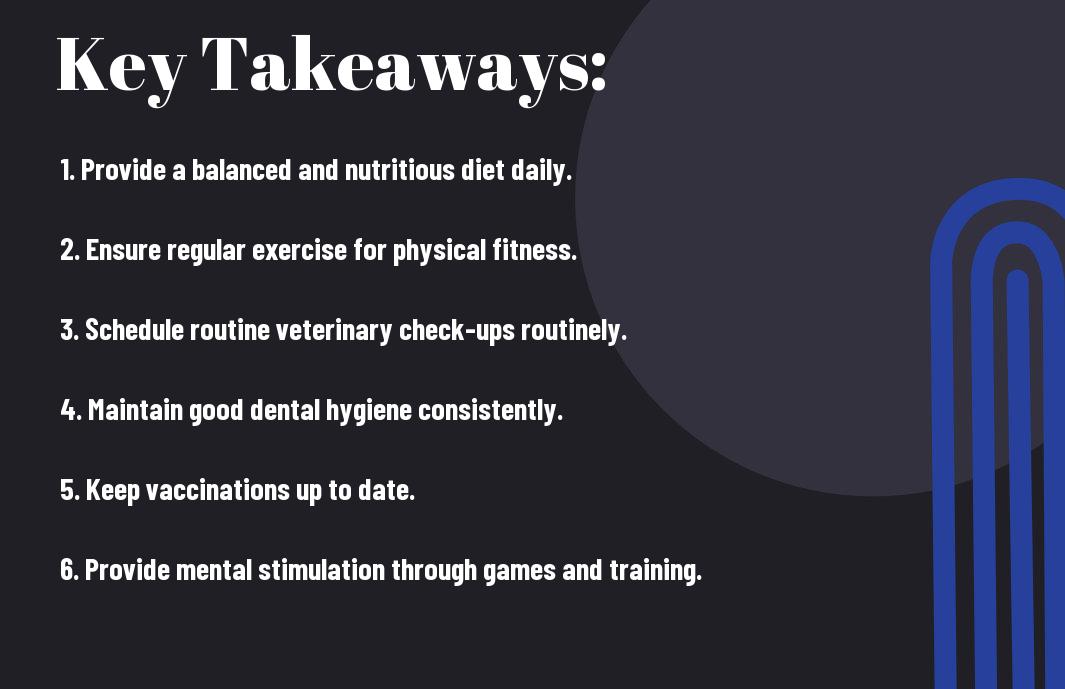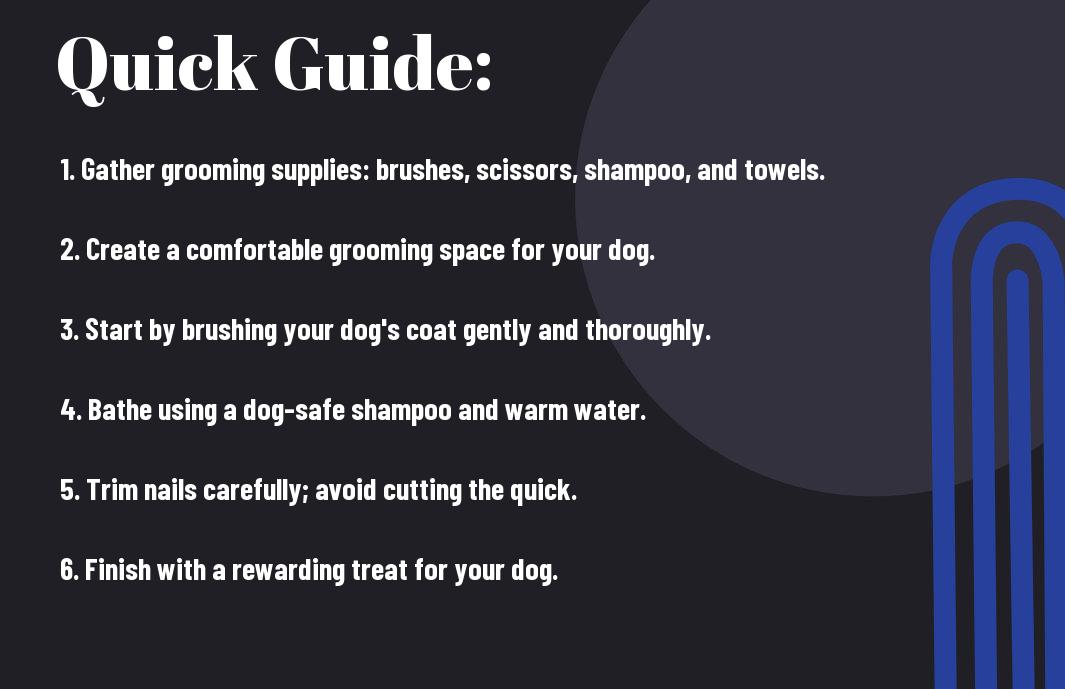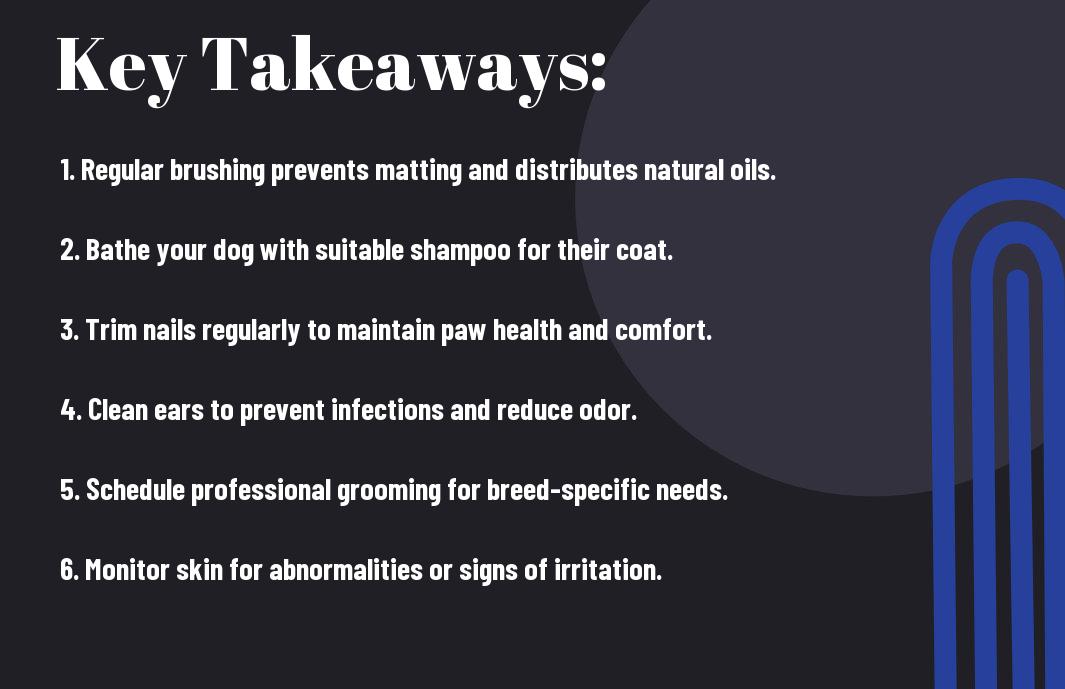With a well-structured routine, you can ensure that your dog receives the care and attention they need to thrive. Establishing a consistent schedule for feeding, exercise, grooming, and training not only promotes your pet’s well-being but also strengthens the bond between you and your furry friend. In this guide, we will explore effective strategies for creating a daily routine that caters to your dog’s physical and emotional needs, helping you become a responsible and attentive dog owner.
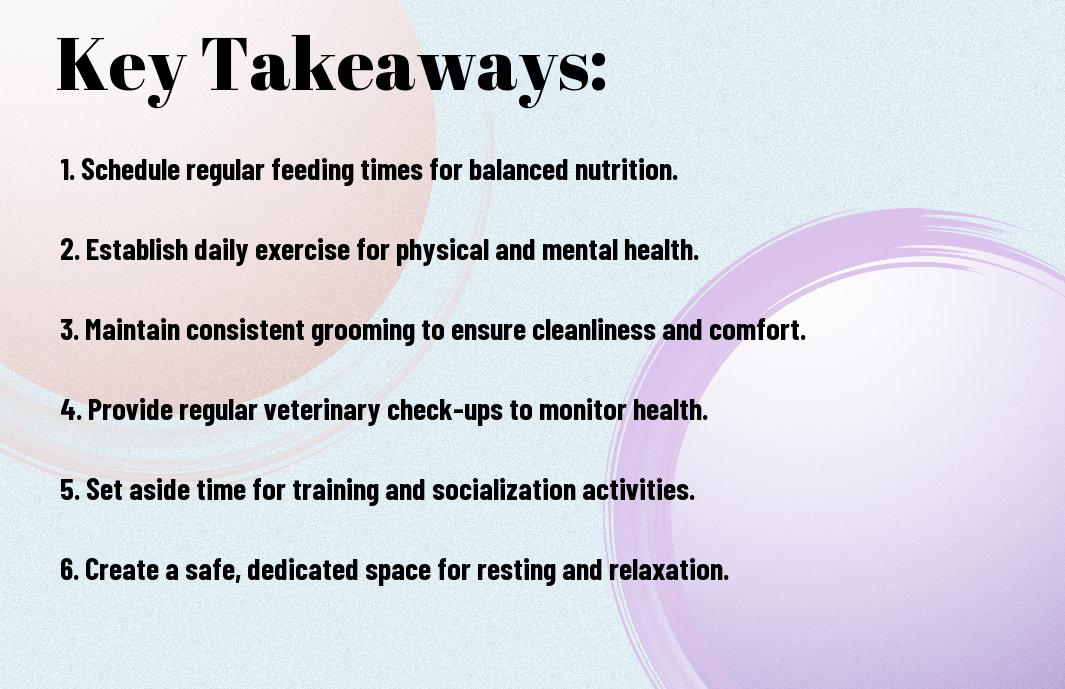

Understanding Your Dog’s Needs
While it’s exciting to welcome a new dog into your home, understanding their needs is vital for their overall well-being. Each dog is unique, and by paying attention to their specific requirements, you can provide a nurturing environment that promotes a happy, healthy life. One of the primary areas to focus on is their physical requirements, which encompass everything from exercise to regular vet check-ups.
Physical Requirements
An adequate level of exercise is vital for your dog’s health. Different breeds have varying energy levels, so it’s vital to tailor exercise to your dog’s specific needs. A high-energy breed may require long walks, runs, or even agility training, while a more laid-back breed may be satisfied with shorter daily walks and playtime in the yard. Additionally, routine health check-ups will help monitor your dog’s physical health, allowing you to react promptly to any emerging issues.
Nutritional Needs
Needs should be addressed for a dog’s dietary requirements, which can vary significantly among different breeds, ages, and health conditions. Your dog needs a balanced diet filled with high-quality proteins, fats, and carbohydrates, as well as vital vitamins and minerals. Consult your veterinarian to select the right food, as they will have knowledge about your dog’s unique nutritional needs based on their specific environment and lifestyle.
And not only will proper nutrition help maintain your dog’s weight, but it can also affect their energy levels and overall mood. Overfeeding can lead to obesity, while underfeeding could impact their health and immune system. It’s important to monitor their food intake, control portion sizes, and provide fresh water at all times to ensure your dog stays healthy and happy.
Social Interaction
Before you can create a routine for your dog, you must understand the importance of social interaction. Dogs are social animals, and they thrive when they have opportunities to interact with humans and other dogs. Regular socialization helps reduce anxiety and behavior problems, promoting a well-adjusted pet. Consider arranging playdates with other dogs or taking your furry friend to dog parks to meet new companions.
Needs for social interaction can vary depending on your dog’s personality. Some dogs will eagerly seek out connection and thrive in busy environments, while others may prefer a more subdued setting with fewer distractions. Observing your dog’s behavior will help you identify their comfort level, enabling you to tailor their social experiences accordingly.
Mental Stimulation
Across the board, mental stimulation is often overlooked when it comes to dog care. Just like humans, dogs need a variety of experiences that challenge their minds and keep boredom at bay. Engaging in activities such as puzzle toys, obedience training, or interactive games can provide valuable mental workouts that enhance your dog’s cognitive abilities.
Mental stimulation can also strengthen your bond with your dog. When you engage in training or play that challenges them, you reinforce your relationship while providing enrichment for their minds. Incorporate mental exercises into your daily routine to ensure your dog remains entertained, well-adjusted, and eager to learn.

Establishing a Daily Routine
Even the most independent dogs thrive on structure and predictability. Having a daily routine not only helps your dog feel secure but also allows you to manage their needs efficiently. By establishing a consistent pattern for activities, you can cultivate a happy and healthy environment for your furry friend.
Morning Activities
Any good day begins with morning activities that set a positive tone for both you and your dog. Start your day by letting your dog outside for a quick bathroom break, which also allows them to stretch their legs and enjoy the fresh air. Follow this up with some affection and interaction to help them ease into the day and bolster your bond.
After the bathroom break, consider engaging in some light interactive play or training sessions. This helps stimulate their mind while reinforcing good behaviors. Activities like fetch, hide-and-seek, or practicing commands can provide both mental and physical engagement that builds a solid foundation for the day ahead.
Feeding Schedule
With a consistent feeding schedule, you can ensure that your dog receives the nutrition they need at appropriate intervals. It’s often beneficial to feed your dog twice a day, once in the morning and again in the evening. This routine not only prevents hunger-related behavioral issues but also aids in digestion and weight management.
Having specific times for meals can also help you anticipate your dog’s needs throughout the day. You’ll find it easier to plan out other activities knowing when your dog is likely to feel hungry. Not only that, but you can create a more interactive mealtime by incorporating puzzle feeders or slow bowls that challenge them cognitively while they eat.
Due to the importance of maintaining a regular feeding schedule, dogs are more likely to establish a routine that keeps their biological clock in sync. This predictability helps minimize anxiety around meal times and fosters a sense of security within their daily life.
Exercise Regimen
Feeding and playing with your dog is great, but a well-rounded routine must include a dedicated exercise regimen. Engaging your dog in regular physical activity is key to maintaining their health, reducing behavioral issues, and keeping them fit. Aim for at least 30 minutes to 2 hours of exercise daily, depending on your dog’s breed, size, and energy level.
Not only is exercise vital for your dog’s physical health, but it also plays a significant role in mental stimulation. Whether it’s going for a brisk walk, running in the park, or indulging in agility training, incorporating variety into their exercise routine will keep things interesting for both of you. Furthermore, social interactions with other dogs during these outings can help reduce anxiety and improve their social skills.
Consequently, a balanced exercise regimen can lead to noticeable changes in your dog’s behavior and overall well-being. A tired dog is typically a well-behaved dog, and ensuring they have ample opportunities to burn off excess energy can significantly reduce unwanted behaviors at home.
Relaxation Time
For all the fun and activity throughout the day, don’t underestimate the importance of relaxation time for your dog. Just like humans, dogs need quiet moments to recharge and relax. Setting aside time for your dog to unwind after their play and exercise will contribute positively to their mood and overall health.
Incorporating relaxation time into your dog’s routine means creating a comfortable space where they can retreat and feel secure. You may provide their favorite bed, blanket, or a quiet area free from distractions. This space allows your dog to seek comfort when they want some peace, which in turn can lead to better behavior and less anxiety.
In addition to this, consider incorporating soothing activities during relaxation periods, such as gentle massage or even calming music. These practices not only strengthen your bond but also help create a serene environment that promotes overall well-being for your dog.
Training as Routine
Now, establishing a routine for training your dog is necessary for their development and your peace of mind. Consistency is key, and a structured training regimen will help your canine companion learn necessary commands, proper behavior, and social interaction skills effectively. By incorporating training into your daily schedule, you will foster a strong bond with your dog while ensuring they are well-adjusted and obedient.
Basic Commands Training
Commands are the foundation of your dog’s training. Teaching them basic commands such as “sit,” “stay,” “come,” and “down” provides not only structure but also a means of communication that enhances your relationship. Begin with the command “sit,” as it is often the easiest for dogs to grasp. Use positive reinforcement, such as treats or praise, when your dog successfully responds to a command. Gradually build up to more complex commands as your dog’s understanding improves.
Incorporating these commands into your walks or playtime can help reinforce the training. Consistency in using the same verbal cues and hand signals will further solidify your dog’s response. You can also integrate short training sessions throughout your day to keep your dog’s attention and enthusiasm high, ensuring learning remains a fun and engaging process.
Behavioral Reinforcement
Between commands, behavioral reinforcement is imperative in shaping your dog’s actions and reactions. Using positive reinforcement techniques, such as rewarding good behavior with treats or affection, will encourage your dog to repeat desired actions. It is vital to reward your dog immediately after the desired behavior occurs, as this helps them connect the action with the reward more effectively. Consistency in your reinforcement will establish clear expectations for your dog.
Further, employing a clicker or a verbal marker can enhance your training sessions by providing instant feedback. This technique highlights the exact moment your dog exhibits the desired behavior, making it easier for them to understand what you want. Over time, you can phase out treats for well-learned commands, as your dog should respond to the cues reliably without the need for constant rewards.
Crate Training Techniques
Basic crate training techniques can provide your dog with a safe haven and assist in house training. Introduce the crate as a positive space by making it comfortable with bedding and toys, and start by allowing your dog short periods inside. Gradually increase the time they spend in the crate, where you can feed them or give them treats, creating a positive association. This process will help your dog view the crate as a sanctuary rather than a punishment.
This training should be accompanied by regular breaks to avoid any anxiety related to confinement. It’s important not to leave your dog in the crate for extended periods, as every dog has different needs. Ensuring that your dog has plenty of exercise and playtime will complement crate training, leading to a well-behaved dog that feels comfortable and secure in their environment.
Socialization Practices
Behind every well-adjusted dog is a thorough socialization plan. Early exposure to various people, environments, and animals is necessary in developing a confident and adaptable dog. Take your dog on walks in different neighborhoods, visit parks, and set up playdates with other dogs to facilitate positive social experiences. Manage these encounters carefully to ensure they are pleasant and non-threatening for your dog.
Indeed, socialization is an ongoing process that should continue throughout your dog’s life. By creating regular opportunities for positive interactions, you are helping to prevent behavioral issues, such as fear and aggression, from developing. Incorporate social events and activities that challenge your dog’s comfort zone gradually, as this will build their confidence and enhance their ability to navigate various situations smoothly.
Regular Health Care
Not only is a routine necessary for your dog’s happiness and well-being, but regular health care is also fundamental to ensuring they lead a long, healthy life. This involves several components including regular veterinary check-ups, vaccinations, grooming, and dental care. All these elements work together to maintain your dog’s overall health and can prevent potential health issues from developing.
Veterinary Check-ups
On a regular basis, you should schedule veterinary check-ups for your dog to monitor their health and catch any issues early on. Typically, it’s advised to take your dog to the vet at least once a year for a general health assessment. During these visits, the veterinarian will examine your dog for any signs of illness, conduct necessary tests, and create a health plan tailored to your canine companion’s needs.
The vet will also help you understand your dog’s specific requirements based on their age, size, and breed. Engaging in regular consultations with your veterinarian ensures that you are proactive about your dog’s health rather than reactive to emerging issues.
Vaccinations and Preventative Medications
Veterinary professionals recommend that your dog receive vaccinations to protect against various diseases and infections. Vaccinations are typically administered as part of a series during your puppy’s first year and will require booster shots as they age. It’s necessary to stay on top of these vaccinations to maintain your dog’s immunity and overall health.
In addition to vaccinations, your veterinarian may prescribe preventative medications for fleas, ticks, heartworms, and other parasites. These medications are vital for safeguarding your dog’s health, and having an open dialogue with your vet will help you determine the best schedule and options available for your pet’s specific needs.
At every visit to your veterinarian, ensure you ask about any necessary updates regarding vaccines and preventative care. Staying informed about your dog’s health will empower you to make the best choices for their well-being.
Grooming Schedule
Grooming not only keeps your dog looking their best but is also an important aspect of their health and well-being. Establishing a grooming schedule tailored to your dog’s breed and coat type will prevent mats, reduce shedding, and lessen the risk of skin irritations. Regular grooming can include baths, brushing, nail trimming, and ear cleaning, each of which contributes to your dog’s overall hygiene.
Furthermore, paying attention to your dog’s grooming needs can help you identify any skin problems or unusual lumps that may require veterinary evaluation. Consistency in your grooming routine fosters a bond between you and your dog while contributing positively to their physical health.
Another aspect of grooming involves establishing a routine for bathing and brushing that aligns with your dog’s needs. For example, long-haired breeds may require more frequent brushing compared to short-haired ones to avoid tangles and matting. Adapting your grooming schedule based on feedback from your vet or dog groomer will ensure your dog remains comfortable and healthy.
Dental Care Routine
Across many dog owners, dental health is often overlooked, but it is a vital part of your pet’s overall well-being. You should incorporate a dental care routine that includes regular brushing of your dog’s teeth, from an early age if possible. This routine not only helps prevent gum disease and bad breath but also contributes to your dog’s overall health, as poor dental hygiene can lead to more significant health issues.
In addition to brushing, consider providing dental chews or toys that promote healthy teeth and gums. Regular vet check-ups should also include dental examinations to monitor your dog’s oral health and address any concerns that may arise.
A robust dental care routine plays an important role in your dog’s long-term health. By being proactive about dental hygiene, you can help them lead a more comfortable life, avoiding painful dental issues that could affect their general health and happiness.
Managing Behavioral Issues
For dog owners, understanding and managing behavioral issues is a vital component of proper care. Addressing these challenges can lead to a harmonious relationship between you and your furry companion, promoting both your dog’s well-being and your peace of mind. Identifying any signs of behavioral problems early allows for timely intervention, leading to effective solutions. Whether it’s excessive barking, anxiety during storms, or trouble with socializing around other dogs, having a solid grasp of the common issues can make a significant difference.
Identifying Common Problems
Behind every behavioral issue lies a range of potential causes. Dogs may exhibit certain behaviors due to fear, lack of proper socialization, or an underlying medical condition. Paying close attention to the specific context in which these behaviors occur is imperative. For instance, if your dog barks excessively only when someone knocks on the door, addressing their fear of unfamiliar people can be a key strategy. As you observe your pet, take note of triggers and patterns that help you pinpoint the root causes.
Consistency in Training
After identifying behavioral issues, the next significant step is ensuring consistency during training sessions. Dogs thrive on routine and repetition, which helps them form clear associations between their actions and consequences. Being consistent in your commands and responses will help your dog to understand your expectations, making the training process smoother and more effective. It’s imperative to involve every family member in the training process to avoid mixed signals that can confuse your dog.
Further, consistency in training extends beyond commands; it also encompasses the behavior you exhibit as a handler. If you are calm and assertive during training, your dog is more likely to respond positively. Practicing the same commands and using the same rewards or corrections breeds familiarity, which is pivotal for your dog’s learning process. Staying committed to a routine will not only bolster your dog’s obedience but also deepen the bond you share.
Positive Reinforcement Techniques
Positive reinforcement techniques are among the most effective methods for modifying unwanted behaviors in dogs. This approach involves rewarding your dog with praise, treats, or playtime for displaying desired behavior, rather than focusing on punishment for negative actions. This not only encourages your dog to repeat those behaviors but also fosters a trusting and loving relationship between the two of you. When utilizing this technique, be sure to provide immediate rewards to establish clear connections between their good behavior and the reinforcement they receive.
Also, integrating positive reinforcement into daily interactions goes a long way. For example, acknowledge your dog for sitting calmly when guests arrive or for walking on a leash without pulling. The more you emphasize the positive aspects of your dog’s behavior, the quicker they will learn to associate good behavior with positive outcomes, promoting a stable and balanced environment for both of you.
When to Seek Professional Help
Behind every dog’s behavior lies a layer of nuances that sometimes require expert insight. If you notice persistent behavioral issues that don’t improve with your training efforts, it may be time to consult a professional. Trainers or behaviorists can offer valuable strategies tailored specifically for your dog’s needs, based on their unique personality and circumstances. Understanding when to seek professional help is imperative to avoiding potential escalation of the issues you face.
Seek out expert assistance especially if your dog exhibits aggressive behavior, debilitating anxiety, or any other concerns that disrupt your household. Consulting professionals not only leads to a more effective resolution but can also provide you with the tools and knowledge needed to continue supporting your dog’s growth long-term. Their experience with various breeds and behavioral situations offers you the confidence to move forward in managing your dog’s behavior successfully.
Adjusting Routine for Life Changes
Your dog’s care routine is not set in stone; it should evolve with changes in your life and your dog’s life stage. Adapting your routine ensures that your dog remains healthy, happy, and well-adjusted to any new circumstances you may face together. Life changes such as adding a new pet, relocating, or transitioning from a puppy to an adult dog all require thoughtful adjustments to your existing practices. Being proactive in modifying your routine can enhance not only your dog’s quality of life but also the bond you share.
Puppies vs. Adult Dogs
Behind every puppy’s playful antics lies a unique set of needs that differ significantly from those of adult dogs. Puppies require more frequent potty breaks, socialization opportunities, and training sessions to help them grow into well-adjusted adult dogs. Your routine should include consistent feeding times, structured play, and short, engaging training periods. As your puppy matures, you’ll need to shift your focus from basic training to building good habits and addressing behavioral challenges.
On the other hand, adult dogs typically thrive on a routine that balances exercise, playtime, and relaxation. While your puppy’s routine might have been packed with high-energy activities, your adult dog may prioritize a steadier, more predictable schedule. This means determining suitable exercise levels and adjusting meal sizes or frequencies to match their changing needs. By regularly assessing your dog’s needs at different ages, you can better tailor your routine effectively.
Aging Dogs Considerations
Below the playful antics of youth, aging dogs face their own set of unique challenges and needs. As a dog matures, you may notice changes in energy levels, mobility, and even health status that all require adjustments to their daily routine. It’s necessary to accommodate these changes by providing shorter walks, modifying playtime, and being mindful of any special dietary requirements your aging dog may need. In addition, regular check-ups with your veterinarian become even more vital as conditions like arthritis or other age-related ailments may need to be managed through therapy or medication.
But adapting to these changes doesn’t just involve physical adjustments; it also encompasses an emotional component. As your dog ages, they may become more anxious or need additional support. Ensuring a comfortable and predictable environment can help alleviate stress. Consider including more rest periods in their routine and being flexible with your expectations, as older dogs may tire more quickly than they used to.
Introducing New Pets
At some point, you may choose to introduce a new pet into your home, which can significantly alter your dog’s routine. This transition requires careful planning and an understanding of your existing dog’s personality. It’s necessary to gradually acclimate them to each other while maintaining their individual routines to reduce stress. This may involve separate feeding times, individual play sessions, and gradual introductions through supervised interactions.
Another key aspect to consider is how your dog’s demeanor may change in the presence of a new pet. Some dogs may exhibit territorial behavior or feel neglected, leading to anxiety or jealousy. Be attentive to these emotions and ensure that you allocate enough one-on-one time with each pet, reinforcing your bond while helping them adjust to their new family member. Regularly reassess their behavior during this transition and adjust your routine as needed to promote harmony within your household.
Travel and Relocation Adjustments
Below the excitement of travel or a new home lies the need to adjust your dog’s care routine accordingly. The dynamic and unfamiliar environment that comes with relocating or traveling can be particularly stressful for dogs. You must provide a structure that mirrors their familiar routine to help ease this transition. Whether it’s ensuring consistency in feeding times, exercise, or even a portable pet bed, maintaining as much normalcy as possible can alleviate anxiety.
For instance, if you plan on taking your dog with you during travel, it’s necessary to scout out pet-friendly accommodations and activities in advance. This preparation will help you incorporate the necessary care elements into your travel plans. Additionally, keep their comfort items, like toys or blankets, nearby during the journey, enabling a sense of security for your pet during these changes.
Summing up
On the whole, establishing a routine for proper dog care is fundamental for both your dog’s well-being and your own peace of mind. By incorporating consistent feeding schedules, regular exercise, and daily grooming into your daily life, you’re ensuring that your dog should thrive in a structured environment. This predictability can help eliminate behavioral issues and promote a strong bond between you and your pet, making every interaction more enjoyable and fulfilling.
Furthermore, attention to health check-ups and training sessions within your routine can enhance your dog’s physical and mental health. Take the time to assess your current schedule and consider how you can better integrate these activities seamlessly. By committing to a well-structured routine, you are not only improving the quality of your dog’s life but also enriching your own experience as a dedicated pet owner.
Q: How often should I walk my dog, and what is the ideal duration?
A: Walking your dog is important for their physical health and mental stimulation. Generally, dogs should be walked at least once or twice a day. The ideal duration varies based on your dog’s age, breed, and energy level. Puppies and high-energy breeds may require longer walks of 30 to 60 minutes, while older dogs or less active breeds may do well with shorter walks of 15 to 30 minutes. Adjust the frequency and duration based on your dog’s needs and observe their behavior during and after walks to ensure they are getting adequate exercise.
Q: What elements should be included in a daily feeding routine for my dog?
A: Establishing a daily feeding routine for your dog involves setting specific feeding times and ensuring a balanced diet. You should feed your dog at the same times every day to create consistency. Generally, adult dogs can be fed twice a day, while puppies often need to be fed three to four times daily. Choose high-quality dog food that meets their nutritional requirements and consult your veterinarian about portion sizes based on your dog’s weight and activity level. Additionally, keep fresh water available at all times to keep your dog hydrated.
Q: How can I incorporate training into my dog’s daily routine?
A: Training is an vital part of your dog’s daily routine and can strengthen your bond while promoting good behavior. Incorporate training sessions into your dog’s daily schedule by allocating short periods, around 5 to 15 minutes, for training. This can be done before walks, after meals, or when you find a convenient time in your day. Use positive reinforcement techniques like treats and praise to reward your dog for obeying commands. To keep them engaged, vary the commands and introduce new tricks gradually, ensuring that training remains a fun and rewarding experience for both you and your dog.
